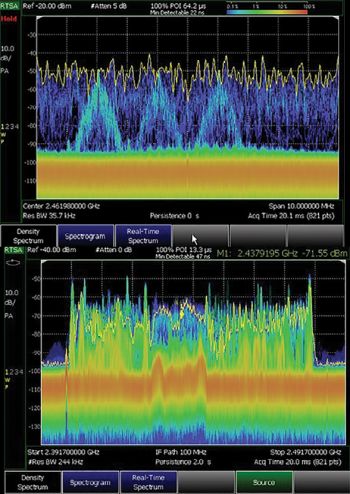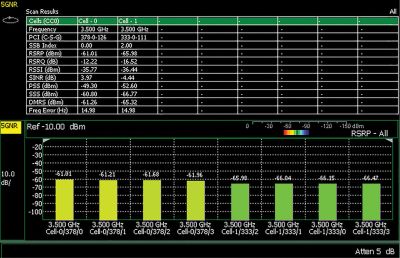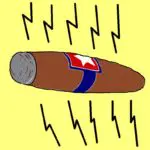A handful of basic techniques go a long way toward characterizing modern communication systems.
Sarah Gross, Keysight Technologies
Field engineers often find that every day presents its own special challenges. A typical work day may involve measuring a variety of devices or signals — cables, antennas, over-the-air 5G signals, or intermittent spurious signals. Successful completion of these tasks requires a basic understanding of RF measurements and a portable, easy-to-use handheld instrument.
There are five common measurements field engineers perform: real-time spectrum analysis (RTSA), noise figure measurements, cable and antenna tests (CAT), over-the-air (OTA) testing, and electromagnetic field (EMF) exposure evaluation. Here’s a rundown on these basic procedures.

Signal interference over wireless networks is on the rise, resulting in poor signal quality that leads to dropped links or choppy audio. Interference profoundly affects wireless devices and communications that range from car radios to mission-critical applications such as public safety.
Traditional spectrum analysis techniques have a built-in dead time during which the analyzer processes the data for display. Intermittent interference may arise during this dead time. Additionally, in a highly dynamic signal environment, wider or longer-duration signals mask weak signals and cause interference. Gapless RTSA, on the other hand, detects and reveals these transient, overlapping signals so engineers can visualize the interferer.
Co-channel interference detection and troubleshooting are the most challenging tasks in a communications network because interferers can hide under the serving frequency. Typically, the user must turn off the carrier transmitter to find any other signals in the same frequency channel. The process of turning off the carrier signal tends to be intrusive and can disrupt normal communication services. Besides, under many circumstances, turning off serving transmitters is not viable, depending on the nature of the services such as base station testing. Fortunately, RTSA profiles over-the-air characteristics, detecting hidden interferers under the serving carrier.
Noise figure measurements
Noise figure measures the degradation of the signal-to-noise ratio as a signal passes through an active or passive device.

One key performance indicator for a receiver is its sensitivity–the ability to reliably discern small signals close to the noise floor. Closely related is the system’s signal-to-noise ratio. Lower noise figure values typically mean better device performance.
Internally-generated noise, however, can degrade device performance. Internally-generated noise reduces the link budget and force use of a more powerful transmitter or a more expensive antenna the receiver. A complete picture of system performance requires an evaluation of internally-generated noise. Minimization of receiver noise is the most cost-effective way to optimize communication systems without reducing quality.
The ability to perform noise figure measurements, in addition to network analysis, spectrum analysis, and power sensor capabilities, enables the complete characterization of amplifiers and converters in the field. Handheld analyzers typically make noise figure measurements using the “Y-factor” method. This technique allows you to measure system components such as amplifiers, downconverters, and upconverters. You can easily view the change in uncertainty in real time, with a built-in uncertainty calculator that displays vertical bars over the trace data. The ability to make these measurements quickly for characterization of the noise figure is important for quickly optimizing designs.
Cable and antenna measurements (CAT) verify and troubleshoot RF/microwave/mmWave transmission systems and antennas. These measurements take place along the coaxial cable that connects a transmitter to its antenna, or between an antenna and its receiver. CAT identifies the location of poor performance in adapters and damaged antennas, as well as where breaks or bends reside in cables.
Faulty cables, connectors, and antennas cause many cellular base station problems. Problems include poor coverage and unnecessary handovers. Component failure frequently results from harsh weather that damages exposed cable system transmission lines. Sheltered cable installations are also subject to heat, stress, and oils leaking into the system. Additionally, cable faults commonly arise at interfaces between cables and connections where soldered joints and crimps in the cable weaken and break.
Transmission lines are often too long to make end-to-end cable measurements that would reveal the location of a fault. There are two cable troubleshooting techniques to try when end-to-end measurement is impossible and a kink or cut forms in a line: Distance-to-fault (DTF) reports the location of each cable fault. Time-domain reflectometry (TDR) characterizes the type of fault, such as a bend in the cable, or cut. A bend in the cable appears capacitive (the return trace reflects downwards) while a cut in the cable appears inductive (the return trace reflects upwards).

Over-the-air (OTA) testing
OTA measurements assess the level of cell coverage needed to ensure continuous connectivity in various mobile communication scenarios, including voice, text messages, and data services.
Wireless networks continue to grow increasingly complex, especially with pioneering technologies such as 5G. Network coverage is a significant challenge because today’s wireless networks consist of layers of macrocells, microcells, and picocells. With users shifting between LTE and 5G, operators face difficulties in defining and troubleshooting wireless coverage.

OTA applications enable LTE and 5G New Radio (5G NR) demodulation to give you insights on cell coverage. This information includes physical cell ID and control channel (often referred to as component carrier) metrics on any given frequency for all available cells. OTA measurements also help address the common problem of identifying missing neighbors.
Some analyzers provide a useful capability: They display the strongest cell on different component carriers. This capability expedites the process of selecting the best frequencies for any given location to optimize inter-frequency handover.
Evaluating electromagnetic field (EMF) exposure
Operators must verify EMF exposure levels for compliance and often use EMF-specific measurements and a triaxial antenna to do so in the field. As technology has developed over time, the RF spectrum has become more crowded. Currently, many commercial technologies function in the low-band radio frequencies. As consumers add more and more smart devices to their lives, the push to explore higher frequencies grows larger.
The characteristics of 5G signals require more base station antennas than LTE — especially in densely populated areas. Besides needing numerous antennas, 5G mmWave signals have different EMF properties than previous standards. Consequently, operators must verify EMF exposure levels in the field, and companies implementing 5G must verify their EMF levels during deployment.

The installation and maintenance of modern communications systems often requires in-field verification and adjustment of components such as filters, duplexers, or antennas. As OTA systems become more complex and evolve, field engineers must carry a handheld instrument that performs the tests necessary to keep a network up and running — and they must know how to use it. An understanding of the measurement basics and technologies gives field engineers the tools to handle the challenges that RF networks present.






Leave a Reply
You must be logged in to post a comment.